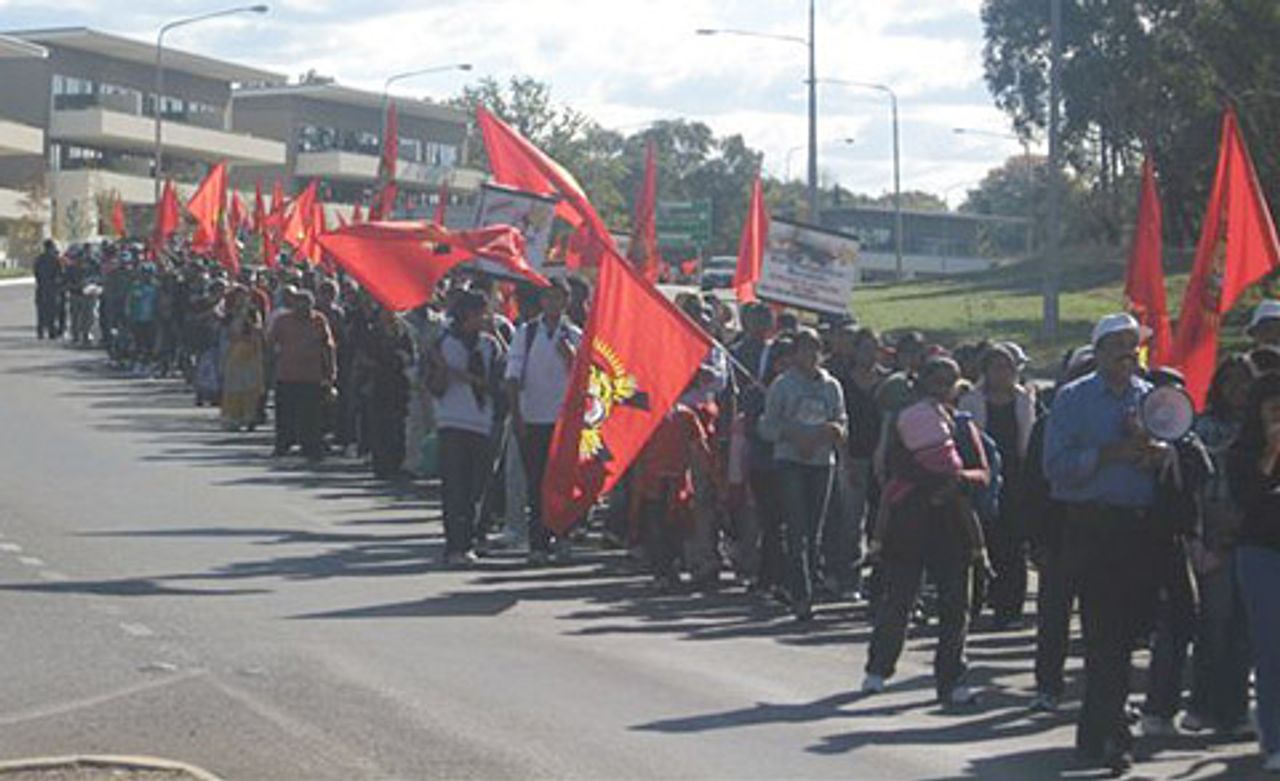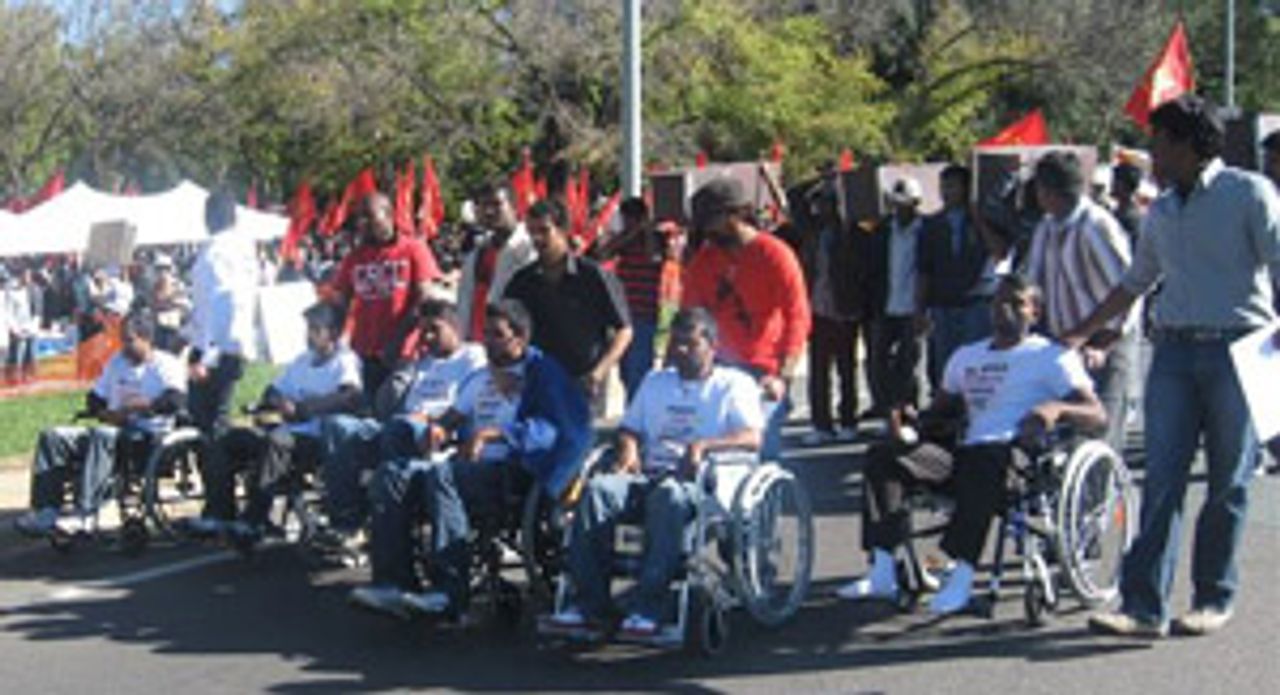More than 3,000 members of Australia’s Tamil community demonstrated in Canberra yesterday to demand a halt to the Sri Lankan government’s military assault on the tiny enclave still held by the separatist Liberation Tigers of Tamil Eelam (LTTE) in the island’s north.
Many of the protesters were young workers and high school, technical college and university students. Contingents travelled hundreds of kilometres from Sydney and Melbourne; some came from as far away as Adelaide.
 A section of the demonstration
A section of the demonstration
After rallying outside the Lodge, the official residence of Prime Minister Kevin Rudd, the demonstrators marched to the Department of Foreign Affairs to ask the Australian government to pressure the Sri Lankan government to call an immediate ceasefire, allow food, medicine and aid into the conflict zone, and grant free movement to all Tamil refugees, including those trapped in the fighting or interned in government camps.
The march banners and placards expressed deep anger over the high civilian toll and the looming massacre of many of the estimated 100,000 people caught in the 20-square kilometre jungle strip surrounded by some 50,000 government troops. “Stop the genocide” and “Australia must halt the atrocities” read some of them.
On the same day, a United Nations official based in Colombo released estimates that at least 4,500 civilians had been killed in the fighting over the past three months and a further 12,000 wounded.
Some hand-held placards voiced hostility toward the aid and support given to the regime of President Mahinda Rajapakse by Australia and the major powers. “No to IMF $US1.9 billion Bail-Out of War-Criminal Sri Lanka”, “Stop Aussie $30m Aid to Sri Lanka” and “Impose Sanctions on Sri Lanka” were among them.
 Tamil hunger strikers
Tamil hunger strikersThe protest was called by Tamil groups, including the Tamil Youth Organisation Australia and the Australasian Federation of Tamil Associations, in response to the actions of six young hunger strikers, three of whom had been fasting for six days. They began their hunger strike in Sydney’s Parramatta Mall on April 11, then moved it to Kiribilli House, the prime minister’s Sydney residence, and finally to the Lodge on April 15. The other three joined the fast in Melbourne on April 13 before travelling to Canberra.
One of the Sydney hunger strikers, Mathivannan Sinnathurai, a 27-year-old university student, collapsed outside the Foreign Affairs Department and was taken by ambulance to the Canberra Hospital in a serious condition suffering exhaustion. The previous day, another hunger striker, university student Sutha Thanabalasignham, 27, was hospitalised because of dehydration.
After agreeing to drink water, Thanabalasingham rejoined the fast. “I have nothing left,” he told the Canberra Times. “I have not been able to contact my family for six months. I don't know if they are alive or dead ... my mother was confined indefinitely in a Sri Lankan government-controlled detention camp and my father lost a leg through government attacks. My family and all the other Tamil civilians in North Sri Lanka are being bombed constantly.”
In a letter to Rudd, Australasian Federation of Tamil Associations chairperson Dr Raga Ragavan appealed to the prime minister to acknowledge the “horrific fate” awaiting the Tamil people and give an “assurance of meaningful diplomatic action”. The letter indicated that the Tamil organisations were having difficulty containing the outrage felt by young Tamils:
“This spontaneous drastic action by our youth indicates that they are frustrated over the lack of positive action taken to date by the Rudd Labor government to end the suffering of their brethren in the Tamil homeland in Sri Lanka. They appear to have lost confidence in their community leaders who have been making representations without much success to the Australian government authorities time and again.”
Neither Rudd nor any other Labor MP appeared at the protest. Instead, a delegation of the hunger strikers met Foreign Affairs Department officials inside the department’s headquarters. Dr Ragavan told the WSWS that the strikers agreed to end their fast because the department had “listened to our concerns and said they would take some of the issues to Sri Lanka”.
During the rally, the organisers promoted illusions that Rudd and the governments of the major powers, particularly the US and Britain, could be pressured into taking action to defend the Tamil people, despite their record of supporting, either tacitly or explicitly, the Rajapakse’s military offensive since his government resumed the civil war in 2006.
Speakers at the rally said little, except to lead chants declaring support for the LTTE and its perspective of a separate Tamil statelet in Sri Lanka’s north and east. Tamil Youth Organisation Australia representative Nisha Navaratnam appealed to the crowd to “alert the governments to hear our people’s pain” and unite behind the LTTE and its leader Velupillai Prabhakaran. “It’s the least we can do, to unite as one,” she declared. The chants led by Navaratnam featured “Australia: Save the Tamils”, “Our leader, Prabhakaran” and “Only solution, separation”.
Socialist Equality Party (SEP) members distributed articles from the WSWS, opening up discussions with many of those present, particularly young people, on the need for a socialist alternative to Sinhala chauvinism and Tamil separatism: to unite the working class, Tamil and Sinhala alike, against the Rajapakse government, for the immediate withdrawal of troops from the North and for a Socialist United States of Sri Lanka and Tamil Eelam.
Unlike at recent Tamil demonstrations in Australia, Europe and Canada, LTTE agents made no attempts to threaten SEP members or block people from reading the WSWS material. However, their supporters called in officers of the Australian Federal Police (AFP) to try to stop the SEP team from campaigning. Two AFP federal protection intelligence agents confronted SEP members, claiming to be concerned they could “incite violence” or cause a “breach of the peace”. When SEP members insisted on their democratic rights to conduct political discussion, the AFP officers backed down.
Numbers of people gave interviews to the WSWS. A worker explained that he was at the protest “to support the Tamils in Sri Lanka. I’m opposed to the way the [Rajapakse] government is going about whatever they’re trying to achieve. They are completely militarist, and showing no concern for humanity or life, or for minority groups. They are allowing people to become completely polarised in their views, so people are becoming very extreme. Tamils who live in Colombo don’t feel safe.
“I have never been to Sri Lanka because my dad is fearful of what could happen if we went back. All my family left Sri Lanka after the 1983 riots. They are all in Canada, the US or Australia.”
Asked whether he supported a separate Tamil state, he said the past experiences meant that a two-state solution was needed so that “Tamils can have a voice”. After some discussion about the possibility of a socialist solution, based on uniting the working class to overthrow the Sinhala establishment, he replied: “I’ve never really looked at it that way. I’ve seen the division along ethnic lines. I don’t know much about the struggles of the working class.”
A group of young women were happy to give their views. A retail worker, said: “The LTTE has been banned as a terrorist group, and we want that ban off. They are not terrorists; they’re freedom fighters. That’s what we’re here for, and also to stop what’s happening in Sri Lanka. We want a ceasefire. The Rajapakse government is killing innocent civilians. They say they’re fighting the LTTE, but that’s not what they are doing; they are killing ordinary civilians. That’s got to stop straight away.
“The Sri Lankan government keeps hiding everything from the media. And they accuse the LTTE of killing the civilians. That just doesn’t make sense. Why would you kill your own people? That’s ridiculous. But the truth can’t get out to the media, so that’s why we are here—to show what’s really happening.”
A medical assistant added: “We want Kevin Rudd to talk to the Sri Lankan government to call a ceasefire. We want more international governments to step in to tell Rajapakse to stop. That’s why there are six boys on a hunger strike, some of them on their sixth day. Hopefully, with all this emotion, Rudd will listen to us and realise that we are serious. These guys [the hunger strikers] are not going to stop until Kevin Rudd says he will have a chat with Rajapakse, or send a letter. He has to do something.”
When asked about the need to unite the working class, Tamil and Sinhala, against a government that, with its predecessors, had a history of violence against workers and peasants in Sri Lanka’s south as well, she said the idea of a socialist federation across the Indian sub-continent “makes sense” because of the “whole history of racism”. But she still thought it would be impossible to live in unity with Sinhalese because of the atrocities committed against the Tamils.
The two women said they did not know what the economic basis or structure of a separate Tamil state would be. After some discussion about the ongoing poverty and inequality in nominally independent East Timor, they agreed to read further WSWS material.
Three high school students briefly explained why they had been participating in the protest throughout the six-day hunger strike. “We want them to call a ceasefire,” one said. “There are people dying in the north of Sri Lanka just because they are Tamils. There are protests around the world to convince governments, like in London and here, to pressure Rajapakse for a ceasefire.
“The Rajapakse government is corrupted. They are trying to wipe out the Tamils in Sri Lanka and that should be stopped. We want equal rights, and Australia is a democratic country and so they should help us. If we have freedom of speech, Kevin Rudd should at least listen to us and at least talk about a ceasefire with other governments.”
A college student from Melbourne said: “Our friends and relatives are suffering. My cousins and a sister are in that war-affected area. The last time we talked to them was three months ago. Now we are unable to contact them. There are no facilities. The last time we were able to communicate with them was via YouTube to the media in the LTTE-controlled area.
“I don’t know why the Australian media is not interested and not covering our problem. We held several protest campaigns in Melbourne but not one of them was telecast. Most Australian people don’t know what’s happening in Sri Lanka.”
